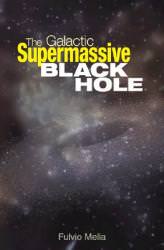Combining large scale astronomical observations with the careful reasoning of physics leads to the widely encompassing field of astrophysics. Apparently, the physical laws that rule interactions on Earth also rule the actions across our universe. Fulvio Melia takes this consideration to task in his book The Galactic Supermassive Black Hole. Within the book, the equations bring reason to some very murky observations and sharpen our view of the heavens.
The target of Melia’s book is our own active galactic centre; the region in and about Sagittarius A*. One of today’s postulations is that each galaxy has a supermassive black hole at its centre. Thus, we’d expect to see a black hole in or near Sagittarius A*. But this raises the question, “How does one see a black hole?”. For, of course, a black hole absorbs everything about it, including light, so there is little for satellites to detect. Nevertheless, though we aren’t able to directly see a black hole, there are many other indicators foretelling such an astronomical entity. Thus, by observation, inference and a great deal of reliance upon physical laws, Melia dishes out reason about the contents of our galactic centre.
To make reason, Melia provides the tools and background throughout his book. He begins with a brief review of relevant observational data about Sagittarius A*. In particular, he looks at emission strengths and characteristics for various energy levels. As an example of the difficulties of this subject, much of the observation supports each other, but yet there’s no exact match. Thus, there’s the need to account for the common problems with astronomy, in that targets move, viewing platforms shake and differences arise for no known cause. Nevertheless, with diagrams, graphs and satellite survey results, Melia shows the data that’s important and provides ways and means to interpret it.
After this review, Melia takes the reader through some simple and some esoteric mathematical manipulations. The simple is setting up transformation matrices for four-dimensional space time. He then goes on to utilize these constructs as a substrate for simulations of the magnetohydrodynamic properties at the galactic centre. These equations come after some development, though many are results from other, external works or papers (that are usually referenced). The equations aren’t present for an intimidation factor, however. Rather, Melia uses them to construct comparative figures and graphs. And, with these, he brings together the hard relations of physics with the softer visages from the satellites. In consequence, the reader, if they can follow the mathematical development, will have effective and viable tools for analyzing the expected properties at our, and other, active galactic nuclei. This is as wonderfully complete as a reader could expect for introductory analytical tools.
And the target audience of this book is the people who are thinking of extending their interests into active galactic nuclei. Melia’s stated goal with the book is to help young astronomers come up to speed with mature primary literature on Sagittarius A*. This book is a great resource for doing just this. By providing background references, establishing equations and comparing theory to observation, this book has excellent breadth. With the derivation of equations and presentation of typical hard data, this book has good depth. For those well into the wonders of astronomy and astrophysics, reading this book would be just the treat to help them reach further into this specialized area of astrophysics.
However, for those readers who are more interested in results or enjoying the view, this book may have too much depth. Integrals, distribution functions and relativistic motion are all present and are necessary preparations for many of Melia’s discussions. His expectation, apparently, is that the reader is comfortable with this technical level. Thus, he doesn’t draw out derivations. A reader, unfamiliar with this level, may soon find themselves grasping for understanding.
Yet, for those who want to make a serious commitment in the field of active galactic nuclei, particularly of Sagittarius A*, this is a very thorough and polished book. The chapters and material follow on naturally. There aren’t surprises nor need for guess work. Somewhat unsettling is the ending. Here, Melia skips from a paragraph on needed telescope upgrades to the next paragraph, where he states that his book is at best a work in progress. The reader, therefore, is left hanging. There’s very little on expected future research efforts, centres of research or practitioners in the field. Thus, if a person is contemplating further study, they may know more of what to do from reading this book, but they will need to look elsewhere on how best to contribute to the field.
The light from far away stars, beautiful in its own right, can carry great meaning. As it bounces off of dust or reflects about great masses of matter, we can infer details. Fulvio Melia in his book The Galactic Supermassive Black Hole combines the little information we can detect from our galactic centre together with our accepted laws of physics. This foundation is just waiting for the next contributor to extend our knowledge into the further reaches of space.
Read more reviews or purchase a copy online from Amazon.com

